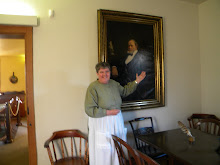Each year at the end of April, the city of Keokuk, Iowa, which is just across the river from Nauvoo, hosts a Civil War Re-enactment. People from all over come in costumes of the period, some dressed as soldiers and some dressed as townspeople who walked among them. (The Nauvoo Missionaries are those people as we take "Nauvoo on the Road" to the event and do demonstrations of life in those days.) They have three days of battle, each taking place in the afternoon for about an hour. There are other commemorations such as a Sunday service, and flag raising, and demonstrations of drilling and firing and other military operations. It really is an amazing experience to step back in history and remember those days that shaped America.

This marker is over in the National Cemetery in Keokuk, but it seemed appropriate to this part of the post. Keokuk, being a river town on the Mississippi, had easy access to bring soldiers who were wounded in and out the hospital that was built here. Because so many soldier died here, this is one of the few national cemeteries in the country. It is so impressive to see the rows of headstones of those who gave the "last true measure of their devotion".

The people who come for this re-enactment each year actually stay in the tents and make it as real as they can. They have firewood stacked and covered to make campfires to keep warm. This was a rainy, cold day. This gives a picture of the regiments that were larger than others, which would have been a realistic picture of how things were during the battles of the war. Some states provided many troops, while others provided few.

It took me a while but I finally found a "southern" group with the ladies of the South in their hoop skirts.

As I walked through the "battlefield", I thought about the first Battle of Bull Run and how people came out to watch as if it were a spectator sport. They even brought their lunches for a picnic.

As I walked around, I thought, "This must have been what it would have been like--people sitting and waiting, finding ways to keep themselves busy while they waited for the orders to attack."

I am amazed how many people are "civil war buffs" purchasing all the equipment to make these re-enactments so realistic. Many of these were the personal property of participants.

Each of the encampments had the regiment they were representing. They also had the flag of the "side" to which they belonged, and the state flag from which they hailed.

Cannons to the left of them, cannons to the right of them--mighty 500!!! They fired these off and it rattled the whole park, of course, they didn't put the balls in them--just the black powder.
 Four score and seven years ago, our fathers brought forth on this contineent, a new nation, conceived in liverty and dedicated to the propostion that all men are created equal.
Four score and seven years ago, our fathers brought forth on this contineent, a new nation, conceived in liverty and dedicated to the propostion that all men are created equal. Now we are engaged in a great civil war, testing whether that nation, or any nation so coceived and so dedicated, can long endure. We are met on a great battle field of that war.
Now we are engaged in a great civil war, testing whether that nation, or any nation so coceived and so dedicated, can long endure. We are met on a great battle field of that war. We have come to dedicate a portion of that field, as a final resting place for those who here gave their lives that that nation might live. It is altogether fitting and proper that we should do this.
We have come to dedicate a portion of that field, as a final resting place for those who here gave their lives that that nation might live. It is altogether fitting and proper that we should do this. But in a larger sense, we cannot dedicate---we cannot consecrate--we cannot hallow this ground. The brave men, living and dead, who strugled here, have consecrated it far above our poor power to add or detract.
But in a larger sense, we cannot dedicate---we cannot consecrate--we cannot hallow this ground. The brave men, living and dead, who strugled here, have consecrated it far above our poor power to add or detract. The world will little note, nor long rmember what we say here, but it can never forget what they did here. It is for us the living, rather, to be dedicated here to the unfinished work which they who fough here thus far so mobly advanced.
The world will little note, nor long rmember what we say here, but it can never forget what they did here. It is for us the living, rather, to be dedicated here to the unfinished work which they who fough here thus far so mobly advanced.












































